Today, a new approach is emerging in the field of marketing and business growth: ‘Growth Hacking’. This concept, popularised by innovative start-ups, involves applying agile and creative methods to stimulate growth and maximise results, particularly in terms of customer acquisition and retention.
However, despite the abundance of resources and information on growth hacking, few studies have looked specifically at its application in the B2B context, and more specifically at how growth hacking can be used to retain customers, using the five phases of the customer lifecycle.
This study aims to understand how companies can put growth hacking into practice, by identifying the specific strategies used. Until now, research has focused mainly on the technical aspects of business, leaving aside the necessary promotional strategies and their strategic exploitation. This qualitative study adopts an approach with a constructivist epistemological posture, collecting data through semi-structured interviews with 5 growth hacking experts, based on the analysis of multiple case studies to explore growth hacking strategies. It sheds light on the importance of these strategies and the mechanisms used to highlight the value of companies. The research findings enabled us to understand growth hacking, identify various growth hacking strategies and develop a growth hacking strategy for customer retention in B2B.
1 Introduction
In a competitive economic environment where companies are constantly looking for innovative ways to maintain their competitive edge, customer retention has become a major issue. This issue is all the more pressing in the B2B sector, where companies operate in a complex and demanding environment.
Training firms, as key players in the field of professional skills development, are no exception to this reality. Customer retention represents a strategic challenge for these firms, as it guarantees the continuity of their business and enables them to maintain lasting relationships with their business partners.
Our customer survey revealed that the main reasons for non-retention of a training firm’s customers are a lack of satisfaction, insufficient communication of relevant information, and last-minute actions (customers being informed at the last minute). These findings raise the question:
“How can we develop an effective growth hacking approach to improve customer retention with training firms?”
To address this issue, specific objectives for the development of a growth marketing approach to customer retention were outlined:
• Analyze the various growth hacking techniques used by B2B companies to boost customer retention.
• Evaluate the effectiveness of a growth hacking strategy in retaining customers in a B2B services market.
• Study the key factors influencing the successful implementation of a growth hacking strategy in a B2B services market.
• Identify the challenges and opportunities of implementing a growth hacking strategy in a B2B market.
• Explore the key steps to take, to optimize the success of implementing a growth hacking strategy in a B2B services market.
2 Literature review
2.1 Growth hacking
Many authors have defined it as an ongoing experimental process (Bohnsack and Liesner 2019), involved in all stages of the customer journey. Its main objective is to grow the business by attracting more customers to consume the company’s exclusive products and services. This is achieved through the continuous use of creativity, social metrics and consumer-oriented strategies (Holiday 2013).
However, according to Sean (2010) growth hacking is more than a business strategy, or an ongoing process, it is above all a state of mind, a philosophy, a way of thinking, which can be adopted by any team or company, whatever its size.
In reading the writings of Casanova (2013) we see that he describes growth hacking as a new form of viral marketing, with users’ increased engagement increasing their propensity to actively recommend content to their community, be it friends, family members, professional contacts or like-minded individuals.
Bohnsack and Liesner (2019) and Feiz et al. (2021) argue that growth hacking involves identifying effective methods for delivering value at scale and developing engagement and trust.
The marketing framework most commonly used in growth hacking is the sales funnel, which runs from acquisition to activation, via loyalty, sales and referrals. The aim is to optimize this process by making each stage of the funnel more efficient and increasing the number of conversions (Troisi et al. 2020).
2.2 The relationship between growth hacking and customer retention (KPI)
Retention is at the heart of the growth hacking strategy, and is today more important than ever in the field of business growth. If a company succeeds in retaining its customers, it has a base of regular users who continue to pay for its products and services. What’s more, these loyal users are more likely to be satisfied and recommend the company to others, which in turn encourages the acquisition of new customers – it’s a virtuous cycle.
Growth hackers also recognize the importance of customer retention for business growth. According to a thematic analysis of presentations by 17 speakers at a 2014 growth hacking conference, one of the key elements of a growth hacking campaign is scalable retention/growth. As a result, they have developed approaches focused on customer retention and loyalty, which are reflected in their business approach. Customer loyalty can be measured using specific tools and metrics.
When it comes to retention and loyalty, Customer Lifetime Value (CLV) is a Key Performance Indicator (KPI) not to be neglected. It designates the net profits expected over the lifetime of a customer for your company, and also determines which customers bring the most value to the company. As a general rule, the loss of low-value customers is less worrying than the repeated loss of customers who generate most of your revenue.
Customer lifetime value is a complementary measure to acquisition cost, as it indicates the maximum investment the company can envisage for a given customer to make the effort worthwhile.
In growth hacking, you should avoid using vanity metrics, which are metrics (data) that give a very nice image of the product, but don’t allow you to influence growth. These metrics are often the most accessible and easiest to measure.
• Measuring the churn rate: The churn rate is the percentage of customers/subscribers who cancel or do not renew their subscription to your service. It’s very important to be able to measure it, even if this metric seems very negative, it speaks for itself.
• Find the north star metric: It’s an objective measure of the real value your product brings to users. This metric won’t be sales, page views, subscribers or any other metric that only measures business profit: it’s the users who are concerned by the „north star metric“. To promote sustainable growth of your customer base, efforts must be focused on the north star metric. Sean (2010), reminds us that there may be several metrics that answer these questions, but advises us to try and keep to just one for the sake of clarity.
Here are some supposed examples of north star metrics: Airbnb – the number of nights booked, which captures the value created on both the host and visitor side. Facebook – active time spent on News Feed, or number of active users using the application daily.
2.3 Growth hacking methods for customer retention
Most authors such as Ellis and Brown (2017), Riddersen and Fong (2016), Ries (2011), Currier (2013), Patel (2016), agreed that the data-driven approach is a central element of the growth hacking strategy. The authors also stressed that user retention is a long-term process that requires more time and planning than acquisition growth.
In addition, they proposed different tools and frameworks that should be used for user retention, but differences were observed. Some authors stressed that habit formation and customer engagement lead to significant improvements in user retention rates, while others suggested that tools such as e-mail marketing, drip campaigns and surveys can increase the number of retained customers.
The definition dates back to 2007, created by McClure under the name Pirate Metrics. The funnel is vital to any growth hacker, so the acronym AARRR refers to the terminology chosen to identify the five stages of a customer’s (user’s) life cycle:
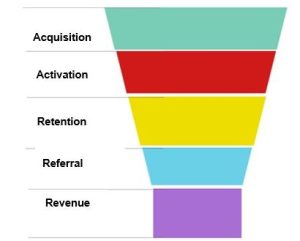
Figure 1: Funnel AARRR
Source: Mc Clure (2007)
Acquisition
Acquisition refers to all the techniques used to attract visitors to a site, using a variety of channels. Social media: social networks (LinkedIn, Facebook, Instagram, YouTube), blogs, etc. SEO: optimizing pages and content strategy to attract customers to the product, a strategy that may take time but is very promising in the long term.
Activation
Activation is a crucial step, as it defines whether the prospect has a certain interest in the service. This definition changes according to the level of engagement chosen (number of visitors to the site who are relevant to the company’s service). One or more indicators need to be tracked and taken into consideration, which will enable the activation rate to be subsequently measured and optimized using tools like Google Analytics (Brunn 2016). During this stage, the growth hacker tries to gather as much information as possible about his prospect, so that he can contact him again later.
Retention
Retention refers to all the mechanisms that keep users coming back to the site. It’s an essential dimension, as it enables us to identify those Internet users who constantly think about and use the service. Indeed, it’s essential to keep them coming back to use or consume again, and this is made possible by the implementation of certain mechanisms. The experts explained this well with the example of the pierced seal, where the growth hacker will have to think precisely how to keep a liquid in this seal by plugging the holes as well as possible so as not to lose customers (Brunn 2016).
Revenue
Revenue corresponds to the capital generated by your website. Some experts consider that a user pays after being retained, which is not always true (impulse purchases).
Recommendation
Recommendation corresponds to all the mechanisms that encourage customers to talk about the service or product around them. It’s a way of winning new customers for free, since many people are more convinced by a service offered by a friend than by an advertising spot.
3 Methodology
The empirical study was guided by an inductive research strategy consisting first of an exhaustive literature review such as the study by Bohnsack and Liesner (2019) or Feiz et al. (2021), followed by an analysis of the website allowing visualization of the customer journey on the site, the analysis is carried out before and after its redesign, and finally semi-structured interviews lasting an average of one hour, were conducted with 5 experts in the field of growth hacking between 07/05/2023 and 15/05/2023, the main objective was to analyze the growth hacking techniques used by B2B companies to boost customer retention. These interviews enable new explanations and investigations, as well as the development of new forward-looking viewpoints (Matthews and Ross 2010).
Our interview guide is based on that of Tuladhar (2022), who studied how growth hacking could retain customers within e-commerce companies in Nepal. It is structured around 3 main themes:
Theme 1: Growth hacking funnel: this section contains 3 open-ended questions asking experts to explain the application of the customer lifecycle to growth hacking.
Theme 2: Customer retention, based on 5 questions formulated in an attempt to understand the approaches used in growth hacking for customer retention.
Theme 3: Proposal of a growth hacking strategy: this last section will take into account the experts’ opinions on the strategy proposed for the training firm.
The analysis method will follow Vernette’s (2017) model, which consists of transcription, categorization, coding, quantification and synthesis.
4 Results
The themes structuring our interview guide served as a basis for categorizing the topics discussed, so we have retained only those themes that served as data enabling us to achieve our objective, which is to study growth hacking and its field of application in depth.
With regard to the first theme, „Growth Hacking Funnel“, specialists insist on adapting the AARRR model based on customer segmentation, and optimizing the funnel stages through relevant KPIs, while keeping in mind the success metrics specific to each company. As for the second, „Customer Retention“ loyalty and constant engagement are paramount. The experts suggest testing products, then implementing a solid loyalty strategy, monitoring indicators such as lifetime value, while avoiding superficial metrics. They recommend the use of various techniques such as segmentation, A/B testing and email campaigns to boost retention. Results are evaluated through KPIs and customer feedback, supported by the use of analytical tools such as Amplitude and Google Analytics for continuous optimization.
| Respondent | Information | Answers |
|---|---|---|
| R1 | Growth hacker, Conducted on: 05/07/2023 Length of interview: 45 min. | Growth hacking is rapid, scalable growth using tricks to increase turnover. In Algeria, companies using this method are rare and finding a real growth hacker is difficult. The strategy depends on the needs of each company, with particular attention paid to customer segmentation. KPIs should reflect the company's overall strategy, and commonly used tools include segmentation, A/B testing, content and data analysis. Growth hacking can be applied to any business. |
| R2 | Growth hacker, Conducted on: 05/08/2023 Length of interview: 75 min. | Growth hacking is the use of digital tools to ensure rapid and exponential growth for a company, particularly start-ups. In Algeria, this is not a common practice, due to the hiring of community managers with broader responsibilities. The expert used tools such as customer acquisition, targeting on social networks and specialised platforms. KPIs are used to measure results, while adapting messages across different channels is essential. The north star metric is considered important, as is customer feedback to resolve problems quickly. Growth hacking can be applied to a variety of sectors, including training firms, focusing on customer retention. |
| R3 | Freelancer in growth hacking, teacher-researcher, Conducted on: 05/11/2023 Length of interview: 34 min. | Growth hacking aims to exploit growth opportunities quickly, using 20% tricks and 80% methodology. It is important to focus on research and to monitor performance by respecting the AARRR funnel. Companies such as Yassir, Heetch and Jumia are increasingly adopting growth hacking. A solid strategy based on an MVP tailored to the market and testing is essential. Customer retention, precise targeting and the use of KPIs such as churn rate and lifetime value are crucial. Understanding customer expectations and adjusting strategy are key. |
| R4 | growth hacker specialist, Conducted on: 05/14/2023 Length of interview: 60 min. | Growth hacking is a method of accelerated growth for start-ups and applications, using original techniques with limited budgets. The AARRR framework is used to acquire, activate, retain, sponsor and generate revenue. Key metrics include CTR, CPC, CPL, CPA and LTV. The aim is to bring users back daily and retain them for as long as possible, using approaches such as gamification and recommendation algorithms based on user preferences. |
| R5 | Growth Hacker, Conducted on: 05/15/2023 Length of interview: 100 min. | Growth hacking is a fast-growth strategy for businesses, using innovative, data-driven techniques. In Algeria, although the concept is new, some companies are adopting it. The objectives and tools vary from company to company, often involving digital marketing methods. The key stages of growth hacking are acquisition, activation, retention, recommendation and revenue. To retain customers, it is important to engage them regularly and respond to their needs. Different factors influence retention, such as trust, price and quality. Specific actions include listening to customers and personalising products. |
Table 1: Results of the experts
Source: Authors
4.1 Proposal of a growth hacking strategy
Following the recommendations collected from the experts in themes 1 & 2, we propose in the following a growth hacking strategy for a professional training firm.
• Website analysis. On the professional training firm’s website, several problems were identified, including:
– inadmissible forms (contact, registration),
– poor SEO,
– irrelevant page content,
– the site was not visually attractive,
– the site was not mobile-friendly.
A before-and-after analysis was carried out using tools such as Semrush (site audit), Attention Insight (visitor attention and CTA percentage), Hotjar (to see the site’s hot and cold spots).

Table 2: Comparative table of results
Source: Authors
• Setting up the growth hacking funnel. Based on our survey, observations and website analysis, a growth hacking approach was recommended to the professional training firm. Each step of the AARRR funnel contains well-defined actions, which we have explained as we go along. See Figure 2.
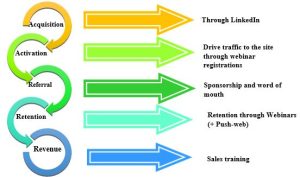
Figure 2: AARRR funnel adapted to the professional training firm
Source: Authors
Acquisition
For acquisition, targeted campaigns on LinkedIn (sponsor message channel) are programmed, knowing that the typical profile of our customers is determined beforehand (building buyer personas). To do this, we have targeted: Human Resources Directors, the Chairman/CEO/General Manager, the Purchasing Director, Training Managers, etc.
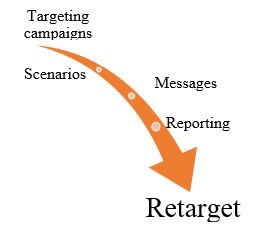
Figure 3: Acquisition process (by the authors)
Source: Authors
Activation
Following the retargeting stage, customers who have shown a certain interest are selected according to the KPIs, from which an e-mailing campaign is created and sent out, inviting customers to a webinar. Registration is made on the website using a registration form, so traffic will be generated on the website.
Referral
For referrals, confirmation e-mails are sent to people who have registered for the webinar (marketing automation). This e-mail contains a Call to Action which enables other people to be invited to the webinar, thus creating a kind of word-of-mouth. The professional training firm in question was already offering sponsorship-style discounts to their customers, but as this formula was not adequately promoted by the firm, and to make the most of it, we included it in our growth hacking approach by sending e-mailing campaigns while targeting the least consumed training courses (promotional reactivation e-mail), for which we used the model proposed by Canevet and Gambatto (2017) a W-shaped sales curve.
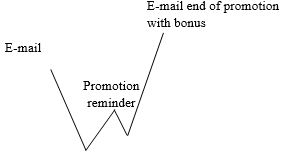
Figure 4: Promotional sales follow a W curve
Source: Canevet and Gambatto (2017)
Retention
In growth hacking, webinars are actions that promote customer retention and loyalty, just like the white papers or PDF guides that we find on websites. However, the strength of webinars in our case is initially focused on offering customers a webinar on the website (in order to encourage traffic to the site); these training courses on interesting topics are initially free. A push notification program is also implemented on the website, these push web notifications are notifications (that users will receive on their computer or phone depending on the device used when registering for the webinar) sent on day-1 of the webinar as a reminder. Later, push web notifications will be sent to webinar attendees to inform them about upcoming training courses. For our north star KPI metric, we opted to measure the time spent per webinar per person, to see if the content really interests customers.
Revenue
This last point consists of measuring the revenue generated, i.e. the number of training courses sold as a result of this approach, and therefore taking into account the number of customers who have actually converted and consumed one of our services since the webinar.
5 Discussion of results
According to our results, growth hacking focuses on an AARRR funnel, where retention plays an important role in increasing the firm’s sales. Unlike traditional marketing, the latter’s funnel doesn’t focus on customer retention, as the main intention is brand awareness, whereas thanks to growth hacking, all possible ways of growth are taken into account, especially customer retention, it’s one of the most effective ways to increase revenue with low investments (Ellis and Brown 2017), this is what ultimately differentiates growth hacking to traditional marketing.
After an in-depth analysis of the levers of customer retention (Satisfaction; Quality of service; Customer experience; Price; Personalization; Loyalty program) to find an appropriate tactic or combination of tactics, we began the process of understanding the customer (profile, interest…), for which we designed a buyer persona, a step our experts also deemed essential. We then moved on to the testing and experimentation process, as well as the analysis of website data, we tracked and measured KPIs in order to continue optimizing the site so that results were generated correctly, as growth hacking requires constantly modifying the offer based on the results of user data analysis (Ellis and Brown 2017).
In the end, we were able to develop the approach (see Figure 5 below) with the help of the experts, integrating the website in order to get traffic, our growth hacking approach was approved by the experts, this model aims to attract more visitors to the website, but also, have better visibility on the LinkedIn professional network by sending personalized messages.
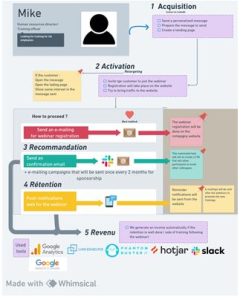
Figure 5: Diagram of the growth hacking approach for the training firm
Source: Diagram made on the website Whimsical by authors
6 Conclusion
The aim of our research was first to understand growth hacking, and then to measure the different techniques used by companies to boost customer retention. To do this, we adopted a qualitative approach, interviewing 5 experts in the field to meet our need to understand growth hacking and measure the feasibility of developing a growth hacking approach within a professional training firm.
The reliability and consistency of the responses collected from the experts interviewed, allowed us to make the modifications suggested by these experts with a view to improving the approach we had initially developed. It’s worth noting that this scientific research is the first of its kind to have been carried out in Algeria, and to have studied, explained and developed a growth hacking approach for a company.
The basic concept of growth hacking is to test a marketing idea quickly and on a shoestring budget, analyze the results using data, then iterate, optimize, execute or adjust the experience using A/B testing, and analyze the data using analytical tools such as Google Analytics, Mixpanel and Optimizely.
As a result, and from the above managerial point of view, our results are encouraging for the Training company, as the implementation of this approach enables the company to solve the problem linked to customer retention, following the favorable results we obtained in relation to the company’s website.
Finally, our research enables the professional training firm to put in place a promising and innovative strategy to detach itself from the parent company’s strategy, as these are two different business sectors, so the professional training firm will be able to outperform its competitors, differentiate itself by offering an innovative formula and ultimately retain its customers. Today, the professional training firm’s website is well referenced, but the firm needs to work harder on customer loyalty and retention, which according to our observations in the field is neglected.
Literatúra/List of References
- Bohnsack, R. and Liesner, M., 2019. What the hack? A growth hacking taxonomy practical implications of growth hacking for firms. In: Business Horizons. 2019, 62(6), 799-818. ISSN 0007-6813.
- Brunn, N., 2016. Growth hacking. Révolutionnez votre stratégie marketing digital. Editions Eni, 2016. ISBN 2746099918.
- Canevet, F. and Gambatto, G., 2017. Le growth hacking: 8 semaines pour doubler le nombre de vos prospects. Dunod, 2017. ISBN 2100769340.
- Casanova, J. J., 2013. Growth hacking – A how to guide on becoming a growth hacker. CSNV Books, 2013. ISBN 100615868711.
- Currier, J. 2013. Growth and network effect businesses at LeWeb tech conference.
- Ellis, S. and Brown, M., 2017. Hacking growth: How today’s fastest-growing companies drive breakout success. New York: Crown Business, 2017. ISBN 9780451497215.
- Feiz, D., Zarei, A., Mibashrazgah, M. M. and Shaabani, A., 2021. Typology of growth hacking strategies along the growth. In: Iranian Journal of Management Studies. 2021, 14(2), 331-346. ISSN 2008-7055.
- Holiday, R., 2013. Growth hacker marketing: A primer on the future of PR, marketing, and advertising. Portfolio/Penguin, 2013. ISBN 1591847389.
- Holiday, R. 2013. Growth hacker marketing: A primer on the future of PR, marketing, and advertising. Portfolio/Penguin, 2013. ISBN 978-0-698-13824-7.
- com, 2023. [online]. [cit. 2023-04-14]. Available at: <https://whimsical.com/>
- Kočišová, L., and Štarchoň, P., 2023. The role of marketing metrics in social media: A comprehensive analysis. In: Marketing Science & Inspirations. 2023, 18(2), 40-49. ISSN 1338-7944.
- Matthews, B. and Ross, L., 2010. Research methods: A practical guide for the social sciences. Pearson, 2010. ISBN 1405858508.
- McClure, D., 2007. Start-up metrics for pirates: AARRR!!! 2007. [online]. [cit. 2023-04-14]. Available at: <https://www.slideshare.net/dmc500hats/startup-metrics-for-pirates-long-version>
- Patel, N., 2016. Growth hacking made simple: A step-by-step guide. [online]. [cit. 2023-04-14]. Available at: <https://neilpatel.com/what-is-growth-hacking/>
- Riddersen, Ch. and Fong, R., 2016. Growth hacking: Silicon valley’s best kept secret. Lioncrest publishing, 2016. ISBN 1619616009.
- Ries, E., 2011. The lean startup. Crown Business, 2011. ISBN 1524762407.
- Sean, E., 2010. Find a growth hacker for your startup. 2010. [online]. [cit. 2023-04-14]. Available at: <https://www.startup-marketing.com/where-are-all-the-growth-hackers/>
- Troisi, J. D., Amodio, D. M. and Moskowitz, G. B., 2020. Understanding and addressing sources of incomplete null hypothesis significance testing: Research practices and recommendations. In: Journal Social and Personality Psychology Compass. 2020, 14(11). ISSN 1751-9004.
- Tuladhar, P., 2022. Growth hacking to retain customers in Nepalese e-commerce companies. 2022. [online]. [cit. 2023-04-14]. Available at: <https://openarchive.usn.no/usn-xmlui/handle/11250/3005167>
- Vernette, E., 2017. Techniques d’étude de marché. Edition Vuibert, 2017, p. 31-48. ISBN 9782311403480.
- Uberwimmer, M., Fureder, R., and Roitinger, C., 2017. Creating value for the customer with industrial services: Selling industrial services is not a matter of price. In: Marketing Science & Inspirations. 2017, 12(3), 2-16. ISSN 1338-7944.
- Wenzler, M., Bhambhani, S. and Schmidthaler, M., 2019. Readiness, use and enablers of digital customer interaction tools in Austria. In: Marketing Science & Inspirations. 2019, 14(2), 2-9. ISSN 1338-7944.
Kľúčové slová/Key words
growth hacking, customer retention, marketing, growth, B2B
rastový hacking, udržanie zákazníkov, marketing, rast, B2B
JEL klasifikácia/JEL Classification
M31
Résumé
Vývoj rastového marketingového prístupu k udržaniu B2B zákazníkov: Príklad z Alžírska
V súčasnosti sa v oblasti marketingu a rastu podnikov objavuje nový prístup „rastový hacking“. Táto koncepcia, ktorú spopularizovali inovatívne začínajúce podniky, zahŕňa uplatňovanie agilných a kreatívnych metód na stimuláciu rastu a maximalizáciu výsledkov, najmä pokiaľ ide o získavanie a udržanie zákazníkov. Napriek množstvu zdrojov a informácií o rastovom hackingu sa však len málo štúdií zaoberalo jeho konkrétnym uplatnením v kontexte B2B, konkrétne tým, ako možno rastový hacking využiť na udržanie zákazníkov pomocou využitia piatich fáz životného cyklu zákazníka.
Cieľom tejto štúdie je pochopiť, ako môžu spoločnosti využívať rastový hacking v praxi a to prostredníctvom identifikácie konkrétnych stratégií. Doteraz sa výskum zameriaval najmä na technické aspekty podnikania, pričom sa vynechávali potrebné propagačné stratégie a ich strategické využívanie. Táto kvalitatívna štúdia využíva prístup s konštruktivistickým epistemologickým postojom a zbiera údaje prostredníctvom pološtruktúrovaných rozhovorov s 5 odborníkmi na rastový hacking, pričom na základe analýzy viacerých prípadových štúdií skúma stratégie rastového hackingu. Príspevok upozorňuje na význam týchto stratégií a mechanizmy používané na zvýraznenie hodnoty spoločností. Výsledky výskumu nám umožnili pochopiť rastový hacking, identifikovať rôzne stratégie rastového hackingu a vytvoriť stratégiu rastového hackingu na udržanie zákazníkov na B2B trhu.
Recenzované/Reviewed
25. September 2023 / 1. October 2023












